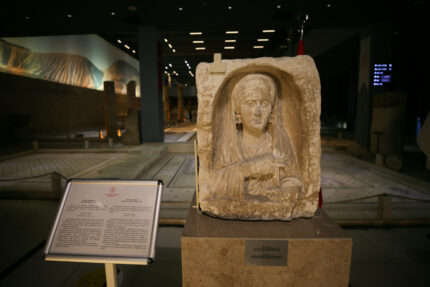Italian authorities have returned a 2nd century A.D. funerary stele looted from the ancient city of Zeugma to Turkey. The stele, deemed by archaeologists to be of extraordinary historical and artistic significance, was given to officials of the Turkish embassy in Rome at the end of April, and this week it was welcomed home in a ceremony at the Gaziantep Zeugma Mosaic Museum.
The stele is carved from a solid block of limestone of a type found in the Gaziantep region. It was the primary stone used for statues and headstones in Roman-era Zeugma. It is a rectangle with a deeply inset arch. Inside the arched niche is the bust of a woman dressed in the traditional chiton of a Roman bride, her right hand over heart holding her veil, her left hand holding a spindle. An inscription in Greek on the base reads “Satornila, the wife who loves her husband, goodbye.”
It was seized from a house in Florence in an investigation by the Carabinieri for the Protection of Cultural Heritage of Venice last year. The suspect had purchased it in France then filed a fraudulent request for a temporary entry certificate, claiming the stele had originated in Italy. Had the certificate been granted, he would have been able to export the artifact without being bound by national cultural heritage protections for five years. Before they would grant the license, the Florence Export Office asked him for proof of legal ownership prior to 1909 (the year Italy’s protection of archaeological assets law came into effect) and legal documents proving its original removal from Italy was legitimate.
The suspect hastily withdrew his application, but his shadiness was in the cross-hairs now. The Carabinieri undertook to reconstruct the real transit history of the stele, with the aid of Turkey’s Culture Ministry, Zeugma archaeologists, Interpol and the Italian Culture Ministry’s database of illicitly stolen cultural assets. Meticulous research into the iconography, style, size, materials and soil traces found on the stele confirmed that it was from Zeugma, not Italy.
The stele is an outstanding example of artistic style of Zeugma in the Antonine Period, and archaeologists believe its inscription will shed new light on the history of the ancient city, especially the local families that adopted Latin names after becoming Roman citizens.
